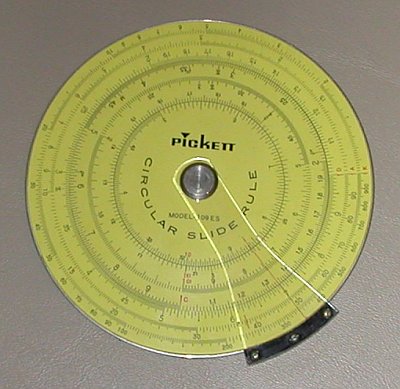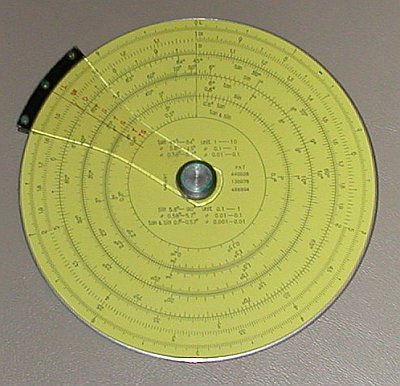Circular Slide Rule

Regular readers of this blog (all five of them) will know that, Selective Luddite™ that I am, I'm a fanatic about slide rules. I keep a slide rule on my desk, and often use it in preference to a calculator. My interest in slide rules dates back to my high school days, in the early 70s, when they were still teaching us in math class how to use slide rules. I got a few slide rules when I was in high school, and I still have a couple of them, including the slide rule pictured here: a Pickett circular slide rule, model 109ES.
This really is something of an oddity. The advantage of a circular slide rule, of course, is that you can never run "off the end" of a scale. Also, it's much more compact: only 4 inches in diameter, my circular slide rule has scales more detailed than those on a standard 10-inch slide rule.

The front has EI, CI, C, D, A, and K scales. The back has L, DI, and D scales, plus half a dozen sine and/or tangent scales. Looking back, I wish I'd thought to buy a slide rule with log-log scales on it: somehow that idea never occurred to me in high school.
Then I went with calculators, which were just coming out and becoming affordable around that time, and for many years I was an apostate from the world of slide rules. Then I began rediscovering those slipsticks, at second-hand stores and antique stores and garage sales. Over the past 10 or 12 years I've built up something of a slide rule collection. But I've never run across another circular slide rule like that one I got back in high school.
Labels: slide_rules








1 Comments:
I knew the man who invented that slide rule. He taught at my school. His name was Stan Arlton. He was an amazingly clever, warm-hearted and slightly eccentric fellow. One of his slide rules traveled with the Apollo missions. His sons invented a computer game called Gato, and later some software called debabbelizer (or something like that). More recently the father and sons were involved in an enterprise of manufacturing hobby helicopters. Unfortunately, they ran into supply problems and had to abandon the plan. He saved a lot of money over the years, but never made a fortune on his inventions because they tended to show up just as technology was changing.
Post a Comment
<< Home